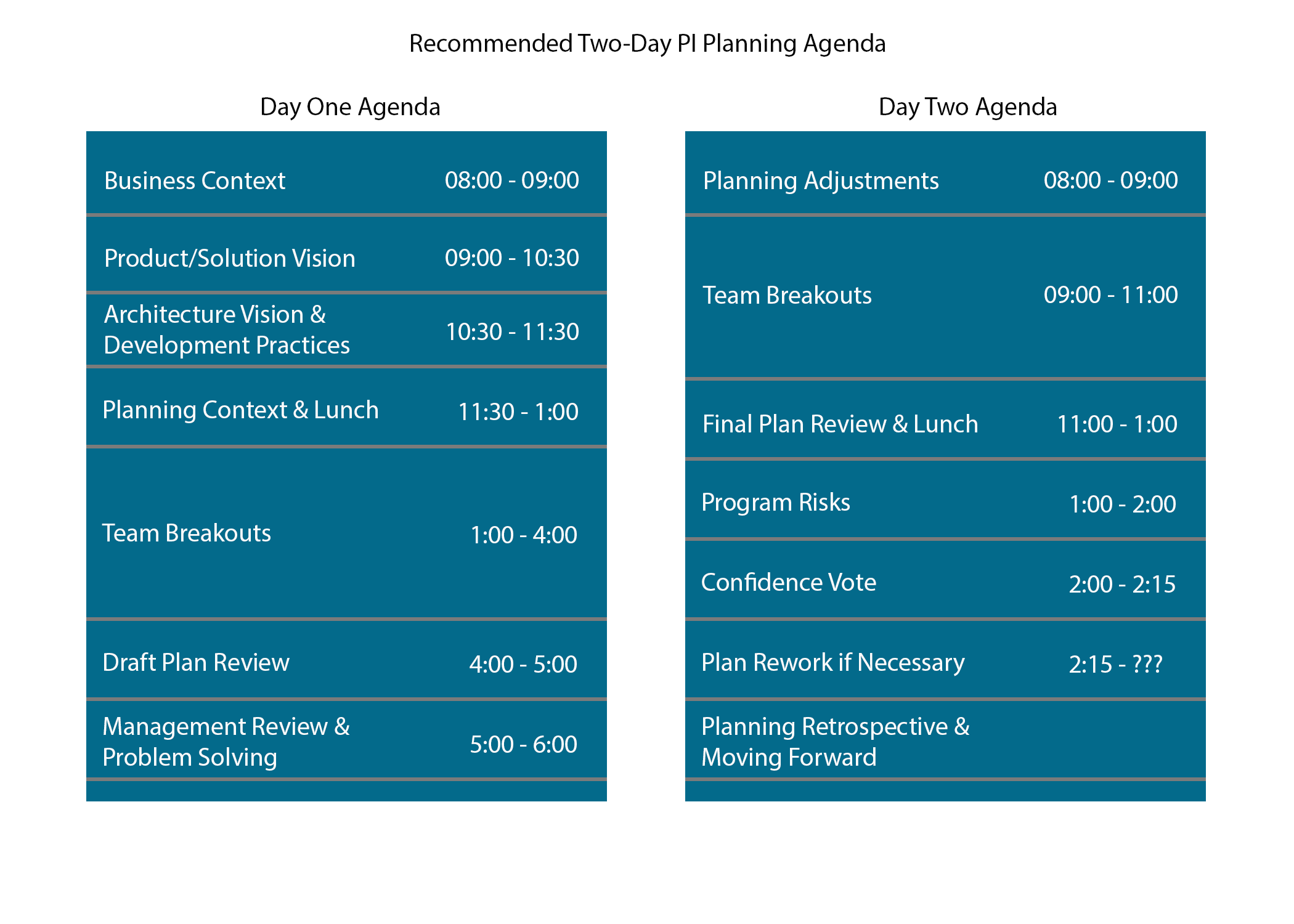At Eliassen Group, we get a lot of questions from clients and members of the community about Program Increment (PI) Planning in SAFe. One that we get frequently is, "What is this PI Planning event, and why should we care?" I'd like to provide an answer. PI Planning is, without question, the most valuable event in the Scaled Agile Framework® (SAFe®). It is critical to the success of an Agile Release Train (ART) and the success of the teams on that ART. For clarity’s sake, an ART in SAFe is the foundational construct that groups people around the delivery of value in the form of a customer solution.
Scaled Agile defines PI Planning as, "Program Increment (PI) Planning is a cadence-based, face-to-face event that serves as the heartbeat of the Agile Release Train (ART), aligning all the teams on the ART to a shared mission and Vision." SAFe further admonishes, "PI Planning is essential to SAFe: If you are not doing it, you are not doing SAFe."
PI Planning is also the longest and most expensive event in SAFe. If you aren’t doing PI Planning well, you’re not just “not doing SAFe well," you’re throwing money down the drain. But more than wasting money, you're wasting the time, energy, and efforts of your biggest competitive advantage -- your people.
What Is the Goal of the PI Planning Event?
The primary purpose of PI Planning is to create alignment between the people doing the work and the people asking for the work. Shockingly, in many organizations we consult with, the people doing the work and the people asking for the work have never had a conversation. Worse yet, the people doing the work often have no idea who the customer(s) is/are for that work and how they will use what is being built for them. In many companies, requirements are created in a vacuum by people who are disconnected from those building the solution, resulting in "solutions" that take too long, cost too much, and don't meet the customers' needs.
The first half of day one of PI Planning is the "ask" from the business to the teams on the ART for the business objectives they want to achieve in the next quarter. This is when the business comes to the ART and explains the "what" and the "why" that will extend and enhance the solution that delivers value for one or more customers. The importance of this cannot be understated. In so many organizations, the people doing the work have no idea how what they are doing on a sprint-by-sprint basis contributes to achieving real business objectives. PI Planning brings everyone together and ensures that they are all operating from the same set of objectives, and that is truly revolutionary and powerful.
What Are the Benefits of PI Planning?
When done correctly, PI Planning is a powerful and effective mechanism for achieving business objectives for customers, stakeholders, and the organizations serving them. Here are some examples:
- Alignment between the business and the people doing the work.
- Transparency among all the members of the ART, the stakeholders, and leadership.
- Team building among the teams on the ART and their business owners.
- Identification of inter-ART and external dependencies and the creation of contracts to deliver those dependencies.
- Identification of team and ART-level risks and the creation of action plans to mitigate them.
- Effective delivery of real value for customers through the presentation of actual business objectives and the commitment of the ART to deliver them.
- Clear understanding of cost and returns on investment via the allocation of the people on the ART to the identified business objectives and the calculation of the value derived from those business objectives.
Who attends PI Planning?
Everyone on the Agile Release Train, Business Owners, Product Management, System Architecture and Engineering, Stakeholders, Suppliers, the System Team, and anyone else needed to create, agree, and commit to a plan for the next quarter. If you're considering PI Planning and you're asking yourself, "Should a certain person or group attend?" the answer is "yes." Better to have them and not need them than need them and not have them. As you exercise your PI Planning muscle, you will get better at knowing who needs to attend.
How to Do Effective PI Planning?
Ideally, these people all come together in the same geography and conduct the PI Planning event in the same room. However, with the advent of COVID and because of the global workforce, we may have to deal with remote PI Planning. Eliassen has previously posted about success patterns for remote PI Planning.
SAFe provides a PI Planning Agenda that will work for almost any organization. This is one of the guardrails in SAFe, meaning you ought not veer from it without good reason, and you can only discover good reason by first using the PI Planning Agenda. The agenda is designed to provide the teams on the ART the current state business context and the vision for the enhancement of the solution for the PI, as well as any architectural or engineering changes needed to enable the delivery of the PI. Then the teams on the ART are allotted time to plan together. This is the time for horse-trading of stories as well as the identification of any and all dependencies.

5 Keys to Successful PI Planning
- Make sure you have an experienced Release Train Engineer (RTE). The RTE is not merely a ceremonial role. The RTE is the lynchpin to successful PI Planning and PI Execution. You want someone who has experience conducting a successful PI Planning event to ensure the event is effective and efficient. If you don't have an experienced RTE, then it is best to get support from external coaches who have the experience so they can co-conduct the PI Planning event with your RTE.
- Stick to the SAFe PI Planning Agenda. The PI Planning Agenda has been exercised by hundreds of organizations thousands of times and is there to ensure you have a successful event. This is one of the guardrails in SAFe that is there to ensure you don't "run off the rails." Avail yourself of the experience of those who have gone before you!
- Have your top 10 features ready and the stories for them refined. This is a guideline, not a guardrail, meaning there is plenty of gray area in which you can operate. That said, it is difficult to have an effective and efficient PI Planning event if teams are looking at requirements (features and stories) for the very first time on day 1 of PI Planning. Certainly, there may be times when newly identified features are brought to PI Planning because they are critical or provide for the ability to meet an urgent customer need. But, that should be the exception, not the rule.
- Practice your presentations. Whether you're doing PI Planning in person or remote, spend some time preparing. Make sure that the materials from each group -- Business Owners, Product Management, System Architecture & Engineering, and the RTE -- are in the same format and that the presenters have practiced at least once. Teams will not well receive a disjointed presentation that seems stilted or unrefined. This is the "ask" of the ART for the next quarter -- do it justice!
- Test your tech, and have a backup plan. This should seem obvious, but if you're using technology "in the room" for in-person PI Planning or for remote PI Planning, make sure you adequately test it. Many of the PI Planning retrospectives point out technology failures as a reason the event wasn't successful. Technology is great and can be very empowering and enabling when it works. If one or more of the enabling technologies fails, ensure that you have a backup plan and know how to execute it. The last thing you want is a bunch of people hanging around twiddling their thumbs while you scramble to implement a workaround.
In Summary
PI Planning is a quarterly event in SAFe that brings the people grouped around delivering value to one or more customers together to plan collaboratively. It is the most important and expensive event in SAFe. It creates alignment between the businesspeople asking for work and the people who are doing the work. It is critical that it is done well, but when it is done well there are significant benefits.
And that's why we at Eliassen Group strongly recommend one more success factor:
Get some help. Again, PI Planning is the most important and expensive event in SAFe. Ensuring that it is effective and efficient and delivers the desired outcomes is critical. If you're looking at conducting your very first PI Planning, this is the most important one. Since your first PI Planning sets the tone for every future one, and it sets the tone for the teams on the ART, it is critical that you get it right. There is no shame in working with someone who has the experience to help you get the most out of this critical event. If you are interested in learning more, read about Eliassen Group's Agile Consulting Services.



.png)